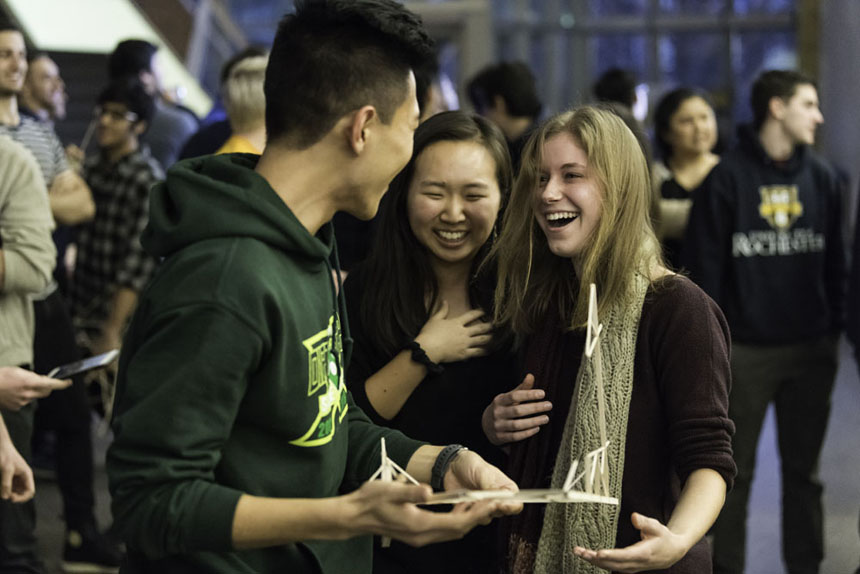'I am more prepared to work as an engineer'
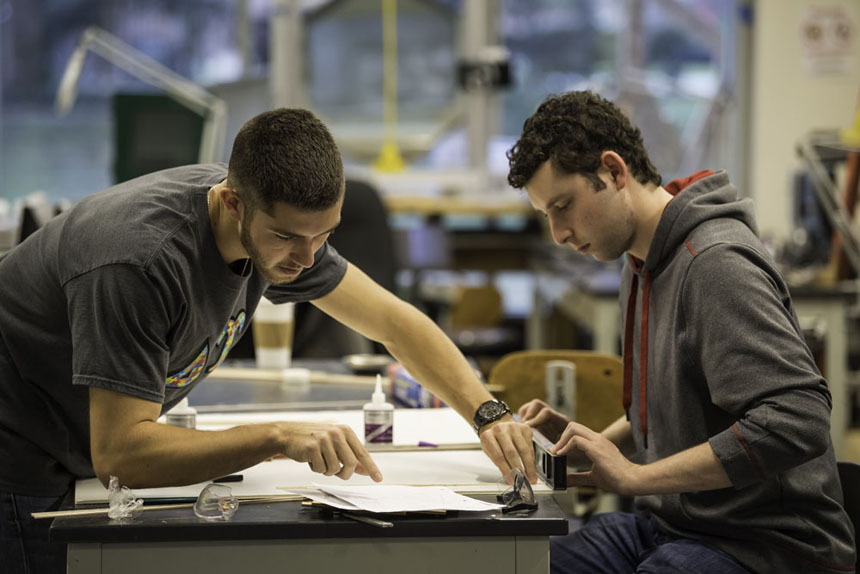
ME 204 gives students the tools to solve real-world problems
“Bending bad; axial good.”
Chris Muir says he would be satisfied if that’s all his students remember from his mechanical design course (ME 204). Translated for a non-engineer: a structure is sturdier when each of its beams bear weight along its axis, without any bending.
However, judging from the comments of Muir’s students this semester, they learned much more than that. One of the toughest courses they experience, ME 204 prepares seniors each fall to design and build prototype devices to solve real-world problems the following spring in ME 205. These culminating design projects, required of all seniors, are often suggested and sponsored by outside companies and agencies.
In ME 204, however, the students had to do four projects, some individually, some in teams.
“By far the heaviest workload we have had so far,” Chris Seely says. “But I think it is understood it is for our own benefit.”
“We learned a ton and if nothing else, it taught us how to handle multiple projects simultaneously,” says Andrew Gutierrez. “ME 204 has been very busy, but because of that I think I am more prepared to work as an engineer.”
Shira Katz took the previous year off from school to work in industry, doing internships with Battelle and Honda. "It was cool to see how much of what we did in this class was important and applicable to future work we'd be doing," she says. "It's a jam-packed course with all types of engineering applications, including manufacturing, simulation, prototyping, design, laser cutting, casting, and 3D printing. And I loved how hands-on the course was."
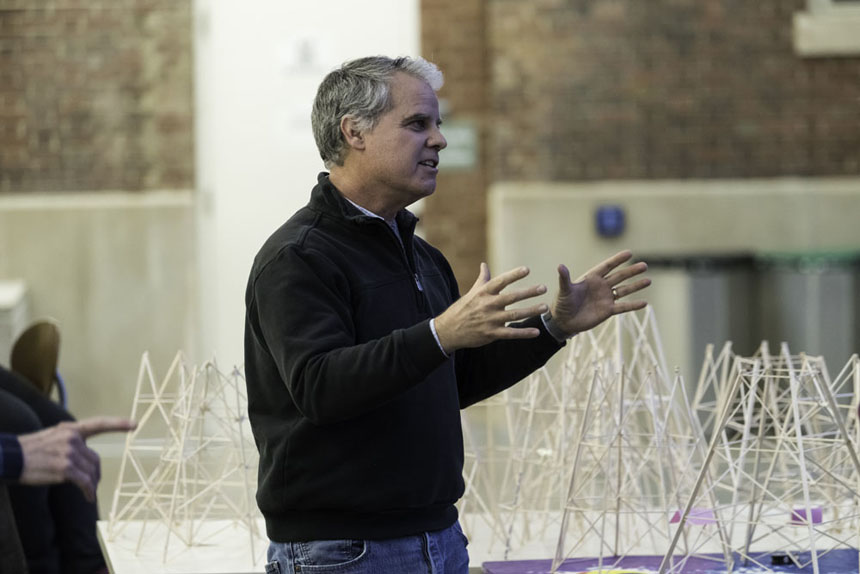
Muir, a non-tenured professor in the Mechanical Engineering department with a PhD from Lehigh University, was a principal engineer at Kodak for 18 years before joining the faculty full time. He received the Student Association Undergraduate Engineering Professor of the Year Award in 2015.
“He is definitely an engineer’s engineer, and it is fairly obvious from the way he teaches and speaks that he has a passion for it,” says student Hunter Bowden.
Here’s a closer look at the four projects Muir assigns to students in ME 204.
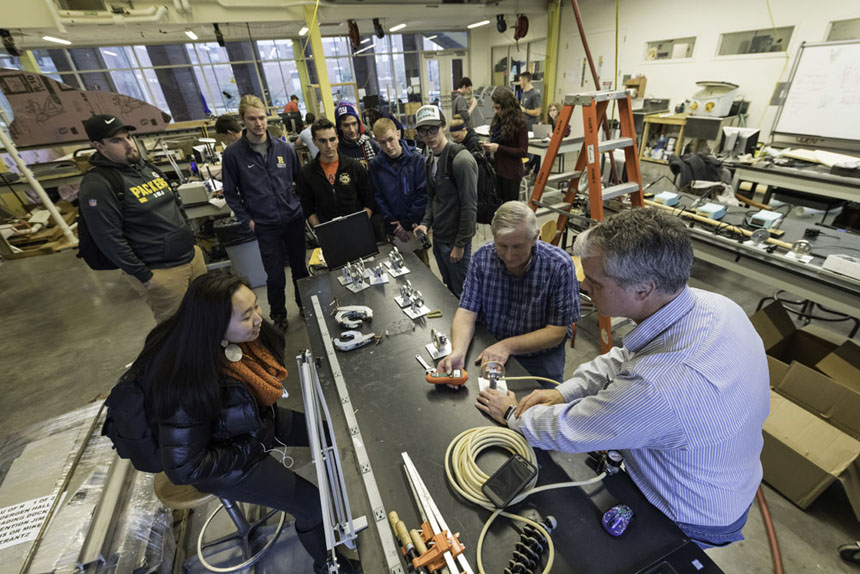
As students look on, Jim Alkins and Muir test how quickly the students’ flywheels spin when air pressure is applied.
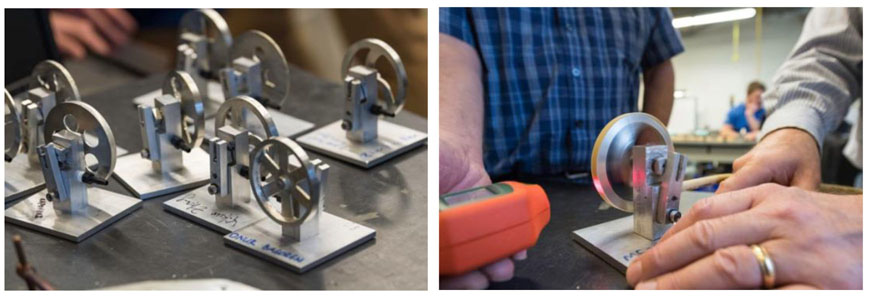
“Make it work”
For many of the students, ME 204 is their first exposure to lathes, mills, and laser cutters in the machine shops at Rettner, Taylor, and Gavett Halls. The course is a team effort involving shop managers Jim Alkins and John Miller as well as the course teaching assistants Peter Miklavcic, Gerrit Bruhaug, Dyreek Brathwaite, and Joshua Baltazar. The casting process was developed with Chris Pratt of mechanical engineering, who works with the students on making their parts.
Each of the 75 students was assigned to fabricate and build an air engine, which can be thought of as a steam engine that runs on compressed air. The goal, Muir says, is to show students that it is one thing to design components for a device with CAD software. Quite another to then actually fabricate those components within required tolerances, and more difficult still to “integrate” the device with “bought” hardware into something that actually works. Working well is another problem still.
“Sometimes the integration takes as long as it does to create the individual parts,” Muir says. “We give awards for the systems with the flywheels that spin the fastest, because if you hit the tolerances on the air valves and the proper clearances, they’re going to have more power, less friction, and run faster.”
“As someone with very little hands-on engineering experience,” says student MiraBodek, “the projects that involve physically making something – using the mills and lathes, for example – were the most challenging for me. But, for the same reason, they were also the most rewarding part, because that's where my skills were lacking.”
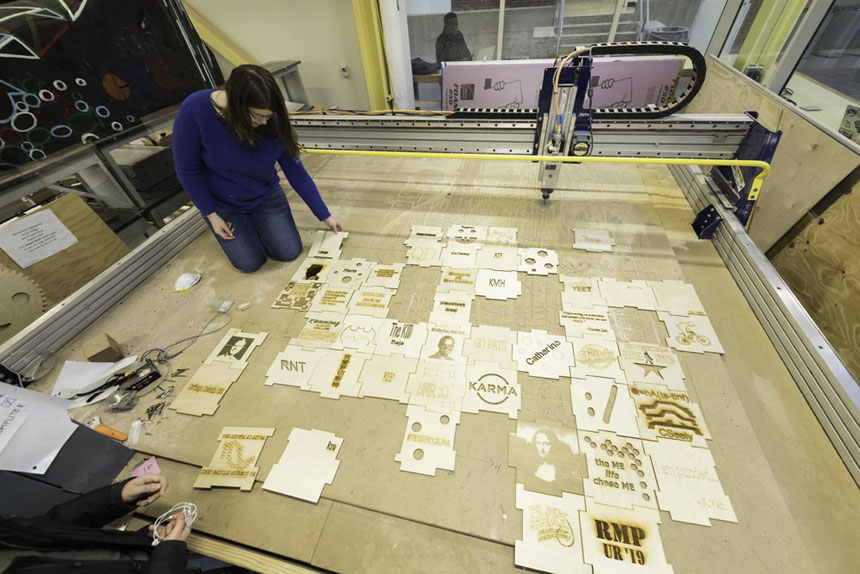
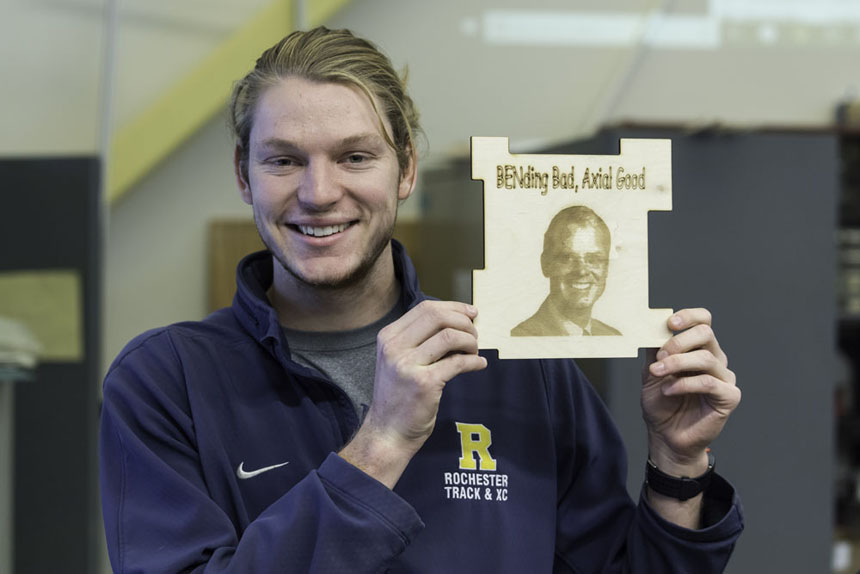
All for one and one for all
Muir worked on integrated printing systems at Kodak, so he knows from experience that engineers cannot simply go off and “do their own thing.” They need to work in concert as part of a team.
Hence the puzzle project. Each student is assigned to do a CAD design for one of the 75 pieces for a team puzzle, and then actually fabricate it. Everyone has a preassigned piece of the puzzle; everyone knows whose pieces they will be interfacing with.
“It is a system problem. So, if it goes together – if the system is successful -- everybody gets full credit,” Muir says. “If even one piece doesn’t fit, it’s one point off for everybody. If it’s your neighbor’s piece that’s off, you get two points off. If it’s your piece that’s off, you get three points off.”
Bottom line: Each student needs to check that their computer model matches their neighbors’ computer models; each student needs to make sure that the piece they fabricate interfaces properly with all their neighbors.
“Everybody is really concerned that everyone else is doing it right,” Muir says. “It’s a lot of pressure if you’re the person who costs the whole class a point.”
Fortunately, on the last day, the students got all the pieces to fit. One year, the puzzle depicted Rush Rhees Library, another Rocky (the school mascot) with a slide rule. This year, Muir let the students come up their own designs.
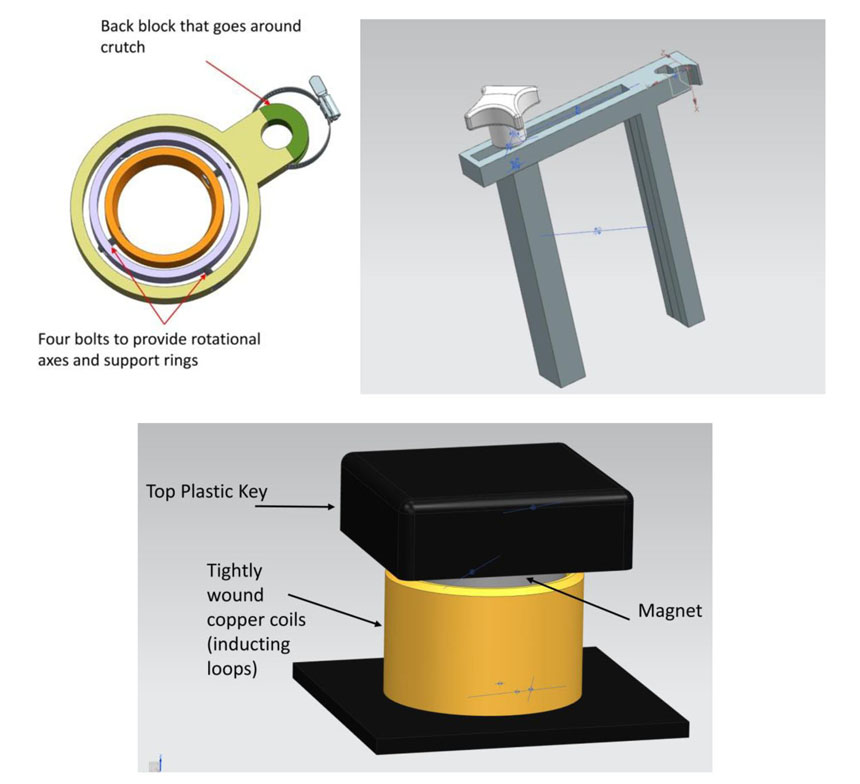
Define the problem
“Students often struggle with this aspect of design,” Muir says. “They think in terms of, ‘Oh, I want to make something cool.’ But in the context of engineering, there has to be a problem that you’re trying to solve.”
So, he asks students to think about something that really annoys them in everyday life – and to define the problem, set appropriate requirements, then design and create a device to address it.
This was Mira Bodek’s favorite part of the class. “It was the first time many of us really had a taste of creating something from start to finish,” she says. “And people had some very cool ideas – from improving umbrellas and floss-pickers, to making the clicking sound of pens less annoying, to creating better car keys. It’s been awesome to see what people came up with.”
Bowden, a Liberty League all-academic quarterback, devised a better cup holder to attach to the crutches he “spends a fair amount of time on” because of sports injuries. Seely came up with a keyboard that charges itself through the motion of clicking the keys.
“A lot of the things they come up with are associated with life in dorms,” Muir says. Catherine Mawn-Mahlau, who likes to look at her smartphone before falling asleep, built a clamp to keep the charging cable from sliding under her bed. Ben Martell made louvers so he could keep his window fan running but block the sunlight that keeps him from sleeping during the day. “Shouldn’t you be awake when the sun’s up?” an amused Muir asked him.
The students were also required to stand in front of the class and give a one-minute talk pitching their idea – an important skill for engineers. “It’s not a hostile audience, be we try to ask difficult questions,” Muir says. “You should be nervous, but it’s your idea. So, I think it’s a good experience.”
The key takeaway from this exercise, Muir says, is to define a problem, then really “narrow down on what it will take to fix it. That’s what they’re going to be doing for someone else next semester – and for the rest of their careers.”
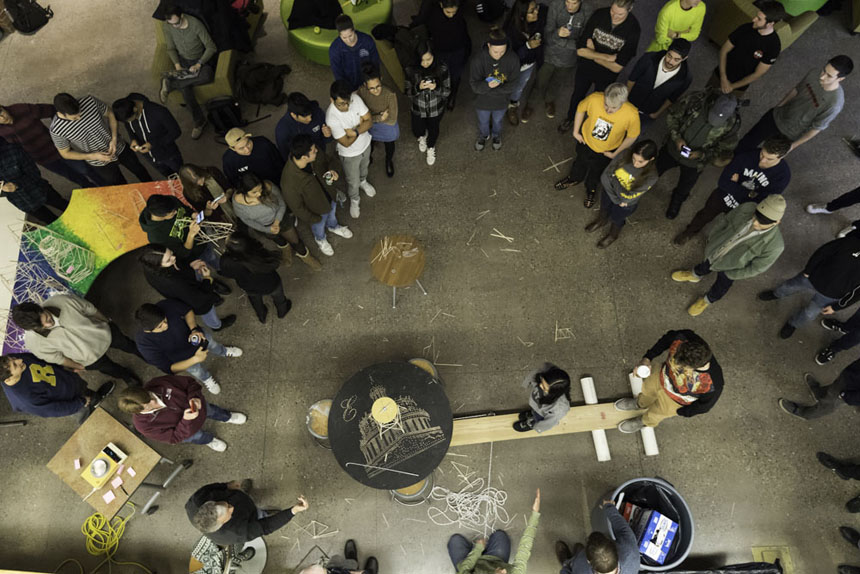
“Walking the plank”
And then comes the main event, a long-standing tradition of mechanical engineering at the University. Students work in teams, competing to see who can make a balsa wood structure that bears the largest amount of force in ratio to the structure’s own weight. Remember: “Bending bad. Axial good.”
Winners get an automatic A for the class. “We are all fairly competitive students, so the class competition is a great way to engage everyone,” Bowden says
The goal is to demonstrate to students that the proper way to approach the problem is from the fundamentals -- in this case, starting with a computational math model and using that to iterate and improve the design.
Too often a design turns into “drawing a picture of something that you think looks like it might work and testing it. That is exactly the opposite of what should be done.” Muir says. Instead, create a computational math model of something that you know will work, then realize a design that can be built around that model.
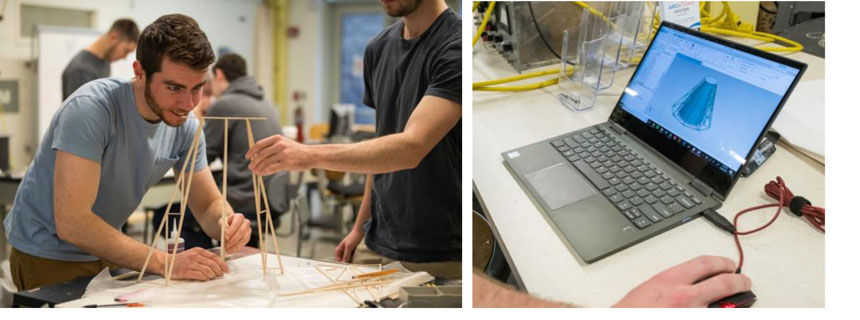
The students use NASTRAN, a finite element, structural analysis code initially developed for NASA, to analyze and refine their design. Their initial intuition of the structure may have a strength to weight of 50-100; after iterations via NASTRAN, they can reach in excess of 5,000.
The project culminates during two hours of combined social event and competitive testing in the Rettner Hall atrium. Each structure is weighed. Each, in turn, is then placed on the testing table. A load plate is placed on top of the structure. The load plate is connected through a load cell to one end of a plank. As classmates look on, members of each team gingerly step closer and closer on the plank.
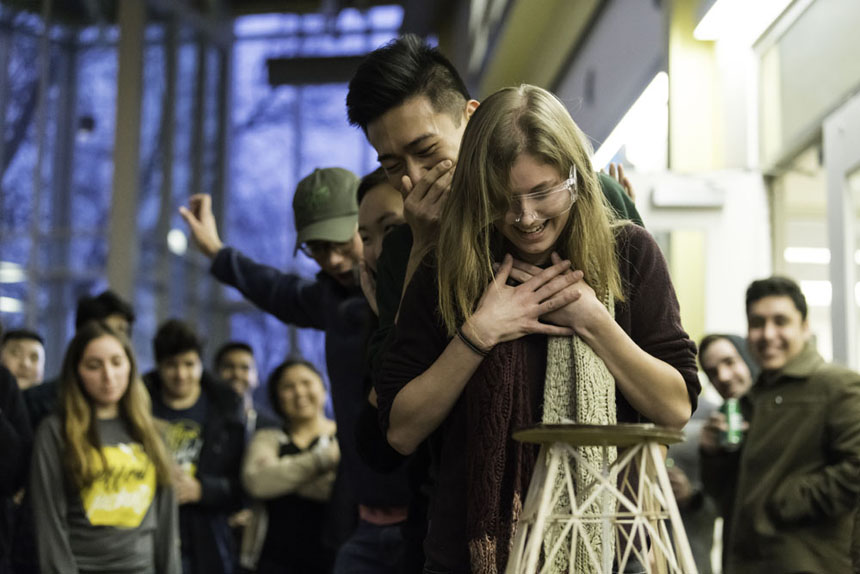
The closer they get, the greater is the downward force placed on the structure, until . . . .
SNAP!
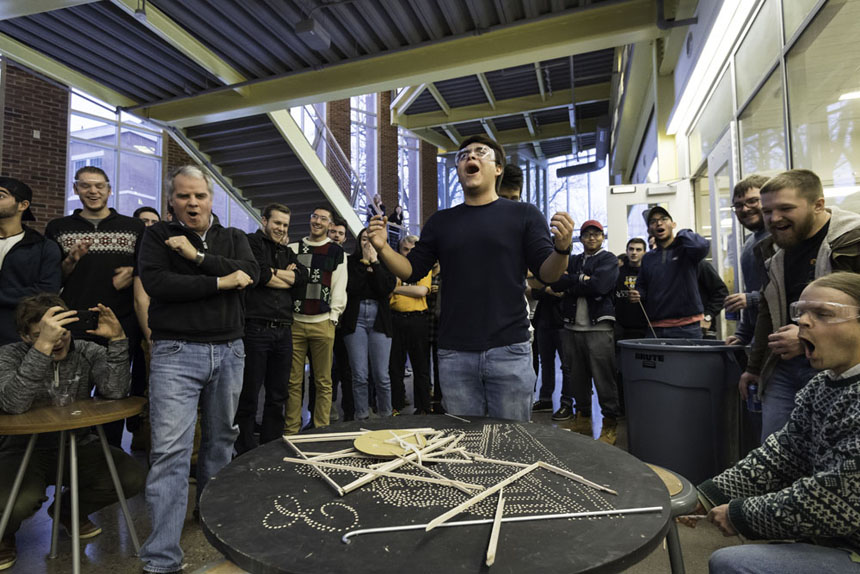
The structure collapses amid groans, cheers, and laughter.
Muir heightens the drama by leaving until the end the structures he thinks will fare best. “The leaders change multiple times over the course of the evening,” Muir says. “It’s exciting.”
There’s even a live leaderboard that’s updated on the atrium’s screen.
“Anybody who is a mechanical engineer at the University of Rochester remembers this competition,” Muir says. “Winners will often list it on their resumes.”
“The best part for me has been the camaraderie built between the senior class through it all,” Bodek says. “We’ve gone through it together, especially the last week when we were all in Rettner slaving over our balsa structures. The moments we’ve had laughing and crying and complaining together have been great.”
